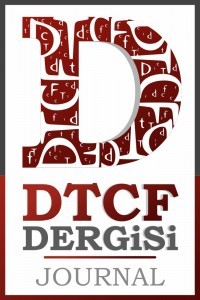Altın Mobius Şeridi: Parçalı Bir Anlatı Olarak Lessing’in “Altın Defter”i
Savaş sonrası dönem edebiyatı, veya postmodern edebiyat, genel olarak ikileme, zıtlık, kaos, ve parçalanma sıfatları ile tanımlanır. Ancak, çok geniş bir alanda kullanılan parçalanma, bu sıfatlar arasında anahtar bir kavramdır. Ayrıca hümanist bütünlük ülküsünün başarısızlığına tanık olan postmodern dünya kendi parçalanmış doğasını kabul etmiştir. Öte yandan parçalanma postmodern romancıların popüler ilgi alanlarından biri halini almıştır. Bu ilgi sadece konusal alanı değil ayrıca birçok postmodern romanın yapısına da yansıtır. Bu açıdan; Nobel Ödülü sahibi Doris Lessing’in, saplantılı denebilecek ölçüde parçalanmaya ve katmanlaşmaya açık romanı Altın Defter, bu konuya verilebilecek kusursuz bir örnek niteliğindedir. Kitap, parçalanmayla sadece konusal olarak ilgili kalmaz; aynı zamanda yapısal olarak da parçalıklıdır. Dolayısıyla; bu çalışma, romancıların anlatı stratejilerinde de yansımasını bulan 20. yüzyılın çok yönlü yapısını, yukarıda bahsedilen romandan örnekler göstererek, “postmodern” diye adlandırılabilecek “durum”un doğal bir sonucu olarak tartışmaya çalışacaktır.
Anahtar Kelimeler:
Parçalanma, Anlatı, Altın Defter, Doris Lessing, Postmodernizm, Postmodern Edebiyat, Postmodern Roman
GOLDEN MOBIUS STRIP: LESSING’S “THE GOLDEN NOTEBOOK” AS A FRAGMENTED NARRATIVE
The post-war period literature, or postmodern literature, is generally described with the adjectives duplication, contradiction, chaos, and fragmentation. However, fragmentation is the key concept among them as the term is employed in a wide range of fields. Witnessing the failure of humanist ideal of wholeness,postmodern world has acknowledged its fragmented nature. On the other hand, fragmentation has become one of the popular concerns of postmodern novelists. This concern does not only show itself in thematic sphere, but also it echoes in the structures of many postmodern novels. In this respect, the Nobel Prize winner Doris Lessing’s The Golden Notebook is quintessential as the novel displays an almost obsessive concern in fragmentation. The book is not only about fragmentation, but also structurally is fragmented. The present study, therefore, attempts to discuss the multi-faceted structure of the twentieth century which found its reflection also in the narrative strategies of the novelists as the natural outcome of what may be called the postmodern condition by citing examples from the abovementioned novel.
Keywords:
Fragmentation, Narrative, The Golden Notebook, Doris Lessing, Postmodernism, Postmodern Literature, Postmodern Novel,
___
- DANZIGER, Claire A. (1996). The Golden Notebook: Reading, Raping, Revenge. Text/Countertext: Postmodern Paranoia. In Samuel Beckett, Doris Lessing, and Philip Roth. New York: Peter Lang.
- HITE, Molly. (1988). “Doris Lessing's The Golden Notebook and The Four-Gated City: Ideology, Coherence, and Possibility”. Twentieth Century Literature. 34 (1):16-29. retrieved from http://links.jstor.org/sici?sici=0041462X% 28198821%2934%3A1%3C16%3ADLTGNA%3E2.0.CO%3B2-E on 2008- 06-09.
- HITE, Molly. (1989). The Other Side of the Story: Structures and Strategies of Contemporary Feminist Narrative. Ithaca and London: Cornell U P.
- HUTCHEON, Linda. (1987). “Beginning to Theorize Postmodernism”. Textual Criticism. 1(1).
- HUTCHEON, Linda. (1995). A Poetics of Postmodernism, London: Routledge, 1995.
- KROUSE, Tonya. (2006). “Freedom as Effacement in The Golden Notebook: Theorizing Pleasure, Subjectivity, and Authority”. Journal of Modern Literature 29(3): 39-56.
- LESSING, Doris. (2002). The Golden Notebook. London: Flamingo.
- LYOTARD, J. F. (1984). The Postmodern Condition: A Report on Knowledge. Minneapolis: University of Minnesota Press.
- MCCRINDLE, Jean. (1982). “Reading The Golden Notebook in 1962”. Notebooks/Memoirs/Archives: Reading and Rereading Doris Lessing, ed. Jenny Taylor. London: Routledge&Kegan Paul. 43-56.
- TAYLOR, Jenny. (1982). “Introduction: Situating Reading”, Notebooks/Memoirs/Archives: Reading and Rereading Doris Lessing. ed. Jenny Taylor, London: Routledge&Kegan Paul. 1-43.
- WILSON, Elizabeth. (1982). “Yesterday’s Heroines: on Rereading Lessing and de Beauvoir”, “The Golden Notebook in 1962.” Notebooks/Memoirs/Archives: Reading and Rereading Doris Lessing. ed. Jenny Taylor, London: Routledge&Kegan Paul. 57-75.
- Yayın Aralığı: Yılda 2 Sayı
- Başlangıç: 1942
- Yayıncı: Ankara Üniversitesi
Sayıdaki Diğer Makaleler
İLHANLI İRAN MOĞOLLARI ORDUSUNDA HİYERARŞİ: ASKERÎ YETKİLİLER VE NİTELİKLERİ
Altın Mobius Şeridi: Parçalı Bir Anlatı Olarak Lessing’in “Altın Defter”i
FİRDEVSÎ-İ RÛMÎ’NİN BİR MÜNAZARASI
ÇAĞDAŞ KORE ROMANININ KURUCUSU GOVANG-SU İ VE MERHAMETSİZ YAŞAM ADLI ESERİ
ENFORMASYON VE BİLGİ KAVRAMLARI BAĞLAMINDA ENFORMASYON YÖNETİMİ VE BİLGİ YÖNETİMİ
